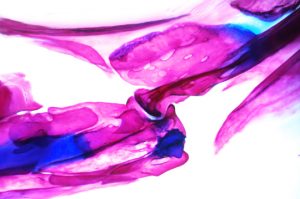#TAGC16 Shorts are brief summaries of presentations at The Allied Genetics Conference, a combined meeting of seven genetics research communities held July 13-17, 2016 in Orlando, Florida.
Elbows, knuckles, and the other synovial joints in your body are mobile marvels of evolution. These joints allow a huge range of possible movements thanks to the presence of a cavity between the articulating bones that is lined by smooth cartilage and filled with a lubricating fluid. This elaborate structure, however, is highly susceptible to wear-and-tear, and inflammation of synovial joints leads to painful arthritis. Results presented at The Allied Genetics Conference last week reveal that, contrary to a widely held view, fish have synovial joints. The results reveal that these joints evolved before the last common ancestor of all bony vertebrates, opening up a promising new avenue for arthritis research.
Synovial joints were widely thought to have evolved as fish left the water and became tetrapods (amphibians, reptiles, birds, and mammals), and to be absent in ray-finned fish, the largest taxonomic group of vertebrates. Joanna Smeeton (University of Southern California) presented evidence for the hallmarks of synovial joints in the jaw hinge and pectoral fin joints of zebrafish, three-spine stickleback, and spotted gar, which are three ray-finned fish species separated by hundreds of millions of years of evolution.
These fish joints are freely movable and surrounded by a joint capsule, with articulating bones separated by a cavity. The cells lining the cavity express a proteoglycan known to lubricate synovial joints. Mutating the gene encoding this lubricant caused zebrafish to develop progressive deterioration of the jaw and fin joints, similar to the effect on mouse and human synovial joints of mutations in the homologous genes. Smeeton hopes a zebrafish model of synovial joint development and degeneration could provide important insights into arthritis and how this widespread chronic disease might be treated.

Adult zebrafish jaw joint stained with alcian blue (cartilage) and alizarin red (bone). Courtesy Joanna Smeeton.
TAGC Program Number Z589:
Fish synovial joints as new models for joint development and disease.
Joanna Smeeton1 Amjad Askary 1 Sandeep Paul 1 Simone Schindler1; Ingo Braasch2,3; Nicholas A. Ellis4; John Postlethwait2; Craig T. Miller4; Gage Crump1
1University of Southern California, Los Angeles, CA; 2University of Oregon, Eugene, OR; 3Michigan State University, East Lansing, MI; 4University of California, Berkeley, CA.
Further reading: https://elifesciences.org/content/5/e16415













